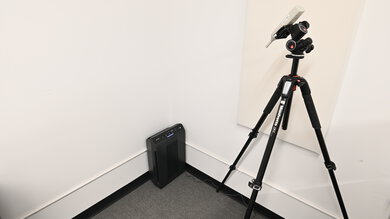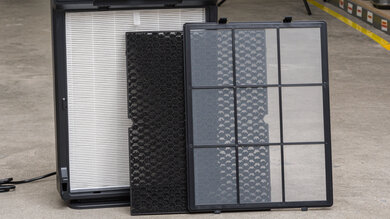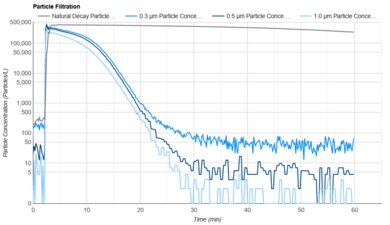- Table of Contents
- Intro
- Best Air Purifier
- Best Budget
- Best Compact
- Notable Mentions
- Recent Updates
- All Reviews
- Comments

Mold is an obvious health risk in any home, but investing in an air purifier can help limit your exposure. The best among them will offer HEPA-level filtration, which can trap up to 99.97% of airborne particles down to 0.3 microns in diameter. Beyond that, you may want to look for features that make an air purifier easier and more convenient to use. There's no shortage of units on the market with quality of life features like Wi-Fi connectivity and built-in particle sensors. These features aren't strictly necessary, but they can increase efficiency, allow you to control the machine remotely, and, more generally, give you peace of mind that your air purifier is doing its job—helping to decrease mold in your home.
If you're looking for other product recommendations, check out our picks for the best air purifiers, the best air purifiers for dust, and the best air purifiers for allergies.
Of course, if you're consistently dealing with mold, you'll need to invest in more than a household air purifier and address the root cause. If the problem is humidity, you can take a look at our recommendations for the best dehumidifiers, the best dehumidifiers for basements, and the best dehumidifiers for bedrooms.
-
Best Air Purifier For Mold
Pets8.5Bedroom8.2Performance Usages: Particle Filtration Rate8.6Particle Concentration7.9The NuWave OxyPure is the best air purifier for mold that we've tested. This unit's main selling point is its multi-stage filtration system that uses washable instead of disposable filters. This system comprises a stainless steel mesh pre-filter that can easily trap dust or clumps of hair, two 'Bio-Guard' filters to trap mold, viruses, and bacteria, an ozone filter, and a combination HEPA/pellet-type activated carbon filter. Except for the HEPA/activated carbon filter, which needs replacing every year, these filters have a 20-year lifespan, so while the unit's upfront cost is rather high, you won't have to spend a fortune on replacement filters. As expected for something this expensive, the NuWave is jam-packed with features. You can operate it from your smartphone using the NuWave Connect companion app, which leverages its built-in particle counter to give you an overview of ambient air quality in your home. You can also use the app to set operating schedules or change the device's settings.
Actual air filtration is very good; the OxyPure provides a very high clean air delivery rate, making it an efficient option for larger rooms. It also does a fantastic job of trapping relatively large particles like mold spores. That said, there's no getting around the fact that this machine is very pricey. If you don't need any of the NuWave model's fancier features, you might be better off purchasing multiple instances of a cheaper model.
-
Best Budget Air Purifier For Mold
Pets8.4Bedroom8.5Performance Usages: Particle Filtration Rate8.3Particle Concentration8.8Check out the Winix 5500-2 if you're looking for an air purifier that can easily deal with mold spores without totally breaking the bank. While its clean air delivery rate falls slightly behind the NuWave, it isn't by much, and certainly not by the margin the on-paper price discrepancy would seem to indicate. Its HEPA filtration system has no trouble dealing with particles like mold spores, and it features a built-in particle sensor that allows it to change its fan speed depending on ambient air quality, so you won't have to babysit the device too much. That said, unlike the NuWave OxyPure, this air purifier lacks Wi-Fi connectivity, so you can't operate it from your smartphone while away from home.
This air purifier has a particle ionizer that imparts a negative charge to airborne particles, causing them to clump together and fall out of the air, where you can then clean them up later. However, ionizers produce ozone, a respiratory irritant, as a byproduct. We didn't find this system to have much impact on overall unit performance, so we recommend you leave it off.
-
Best Compact Air Purifier For Mold
Pets6.9Bedroom7.4Performance Usages: Particle Filtration Rate6.7Particle Concentration7.9If you want a compact air purifier for dealing with mold, the Levoit Core 200S is worth a look. While it can't compete with a full-size unit like the Winix 5500-2 in terms of clean air delivery rate, it still offers a solid performance and will do quite well in smaller spaces, like a bedroom or office. Its main filter technically isn't HEPA-certified, but its filtration performance is still sufficient to trap particles like mold spores. One advantage over the Winix model is its integrated Wi-Fi connectivity, which allows you to run the device while you're away from home, set operating schedules, and set up reminders to replace its filters. Unfortunately, unlike the Winix, it lacks a built-in particle sensor that would allow it to adjust its fan speed automatically depending on real-time air quality.
Notable Mentions
- Honeywell HPA300:
The Honeywell HPA300 is a full-sized household air purifier with HEPA filtration. It has a higher clean air delivery rate than the Winix 5500-2, but is much louder and lacks a built-in particle sensor.
See our review - Corsi-Rosenthal Box:
A Corsi-Rosenthal Box is a homemade air purifier made from a quartet of 3M Filtrete air filters and a box fan; we built our own using this guide. This setup delivers good air filtration performance but is also loud and very bulky, making it best suited to unfinished basements or garages.
See our review
Recent Updates
-
We've checked to ensure our picks are in stock and represent the best choices for most people. We also made minor text changes for clarity.
-
We corrected the Corsi-Rosenthal guide link. We also made some minor text changes.
-
Ensured all the main picks are still available and represent the best fit for user needs.
-
Small text changes for conciseness and clarity. No change in recommendations.
All Reviews
Our recommendations above are some of the best air purifiers for mold for most people. We factor in the price, feedback from our visitors, and availability.
That said, there's no single best option that will suit everybody; your needs will depend on your budget, the size of your living space, your tolerance for operating noise, and whether you like having a device with convenience features like Wi-Fi connectivity. If you'd like to choose for yourself, here's the list of all our air purifier reviews.
Comments
Best Air Purifiers For Mold: Main Discussion
What do you think of our picks? Let us know below.
Looking for a personalized buying recommendation from the RTINGS.com experts? Insiders have direct access to buying advice on our insider forum.
- 21010
I have read several articles indicating that this model includes an LG Nano IPs panel. is this true or false?
Referencia: https://pcmonitors.info/samsung/samsung-s27ag500-165hz-wqhd-ips-model/
Update: Updated text throughout the review according to Test Bench 2.0, mainly in the Verdict and Motion sections.
- 32120
Hi, Thanks for this review! Just a question: in the post-calibration you wrote a brightness setting of 9. Is It correct? Since its range is 0-100, didn’t you mean 90? Thanks!
We aim to calibrate at a brightness of 100 nits, so we usually need to set the monitor to a low brightness setting, which is the case here :)
- 21010
Hi, Thanks for this review! Just a question: in the post-calibration you wrote a brightness setting of 9. Is It correct? Since its range is 0-100, didn’t you mean 90? Thanks!
Edited 11 months ago: Typo error Update: Clarified that the Samsung Odyssey G5/G51C S27CG51 is another monitor with a higher Contrast for deeper blacks.

















